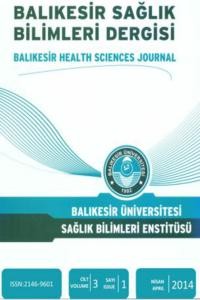Abstract
AMAÇ: Bu çalışmada, ikinci basamak sağlık merkezinde çocuk hastalarda uygulanan perkutan nefrolitotomi operasyonu eneyimizin sunulması amaçlanmıştır.
YÖNTEMLER: Ocak 2010 ve Ekim 2013 tarihleri arasında kliniğimizde mini-perkutan nefrolitotomi (PNL) operasyonu uygulanan 44 hastanın dosyaları retrospektif incelendi. Gerekli laboratuar ve radyolojik tetkikler sonrasında cerrahi yapılacak hastalara PNL uygulandı. Operasyon sonrası radyolojik tetkikler ile rezidü taş varlığı araştırıldı. Dört milimetreden büyük rezidü taşlar için takip, ESWL (Ekstra korporeal şok dalga litotripsi) veya tekrar PNL uygulandı.
BULGULAR: Mini-PNL yapılmış toplam 44 hastanın 15’i kız, 29’u erkek ve yaş ortalaması 11.5 (3-16) idi. Ortalama taş yükü 435.7 mm2 (150 – 900 mm2) olarak saptandı. İşlem sonrasında taşsızlık %84.1, klinik olarak önemsiz taş (<4mm) % 11.36 ve %4.54 ESWL ihtiyacı olabilicek rezidü taş gözlendi. %4.5 hastaya kan transfüzyonu yapıldı. Yedi hastada ameliyat sonrası ateş izlendi. Ameliyat sonrasında bir hastada üretererenoskopi yapılması ve bir hastada da üreteral double j stent takılması ihtiyacı oldu.
SONUÇ: Pediatrik PNL operasyonu, ülkemizde genellikle üçüncü basamak sağlık merkezlerinde yapılmasına karşın deneyimli ikinci basamak merkezlerde de yapılabileceği kanaatindeyiz
Keywords
References
- 1. Menon M, Resnick MI. Urinary Lithiasis: etiology, epidemiyology and pathogenesis. Alan J. Wein (Editor in chief) Campell’s Urology,. 9. Baskı, 2. Cilt, 42. Bölüm. Sounders. (2007)
- 2. Muslumanoglu AY, Binbay M, Yuruk E, Akman T, Tepeler A, Esen T, Tefekli AH. Updated epidemiologic study of urolithiasis in Turkey. I: Changing characteristics of urolithiasis. Urol Res. 2011;39(4):309-14.
- 3. Matlaga BR, Assimos DG. Changing indications of open Stone surgery. Urology 2002;59(4):490-4.
- 4. Zeren S, Satar N, Bayazit Y, Bayazit AK, Payasli K, Ozkeceli R. Percutaneous nephrolithotomy in the management of pediatric renal calculi. J Endourol 2002;16(2):75-8.
- 5. Oral İ, Nalbant İ, Öztürk U. et al. Our experience with percutaneous nephrolithotomy in pediatric renal stone disease. Turkish Journal of Urology. 2013; 39(1): 35-8
- 6. Özden E, Şahin A, Tan B, Doğan HS, Eren MT, Tekgül S. Percutaneous renal surgery in children with complex stone. J Pediatr Urol. 2008;4:295-8.
- 7. Altıntaş R, Beytur A, Oğuz F,Çimen F, et all. Minimally invasive approaches and their efficacy in pediatric urolithiasis. Turkish Journal of Urology. 2013; 39(2): 111-5
Abstract
OBJECTIVE: The aim of this study was to evaluate the results of mini-percutaneous stone surgery that performe in a regional state hospital.
METHODS: We retrospectively analyzed 44 mini-percutaneous nephrolithotomy (PNL) performed cases that treated at our clinic between January 2010 and August 2013. After necessary laboratory and radiological investigations, we performed PNL for the patients those diagnosed as having stones needed surgery. After surgery, we investigated radiologically whether residual stone fragments remained or not. When there were residual stone fragments (bigger than 4 mm), we performed SWL, repeated percutaneous interventions and surveillance protocols.
RESULTS: Of the totally 44 patients (15 girls, 29 boys) underwent mini-PNL at our clinic. The mean age was 11.5 (range: 3-16) and mean stone burden was 435.7 mm2 (range: 150-900). Stone- free rate was 84.1% and the rate of the patients who have residual stones (bigger than 4mm) was 11.36% and SWL was performed 4.54 % patients in the following procedure. Totally only two patients (4.5%) underwent blood tranfusion and postoperative fever was observed 7 patients. Ureterorenoscopy was performed one patient after surgery, the double J stent was replacement in one patient.
CONCLUSION: In our country, mini-percutaneous nephrolithotomy in pediatric age group is one of the surgeries which are mostly preferred to be performed in tertiary care centers. Our results supports the idea that this surgery can be performed by experienced surgeons even in secondary care centers.
References
- 1. Menon M, Resnick MI. Urinary Lithiasis: etiology, epidemiyology and pathogenesis. Alan J. Wein (Editor in chief) Campell’s Urology,. 9. Baskı, 2. Cilt, 42. Bölüm. Sounders. (2007)
- 2. Muslumanoglu AY, Binbay M, Yuruk E, Akman T, Tepeler A, Esen T, Tefekli AH. Updated epidemiologic study of urolithiasis in Turkey. I: Changing characteristics of urolithiasis. Urol Res. 2011;39(4):309-14.
- 3. Matlaga BR, Assimos DG. Changing indications of open Stone surgery. Urology 2002;59(4):490-4.
- 4. Zeren S, Satar N, Bayazit Y, Bayazit AK, Payasli K, Ozkeceli R. Percutaneous nephrolithotomy in the management of pediatric renal calculi. J Endourol 2002;16(2):75-8.
- 5. Oral İ, Nalbant İ, Öztürk U. et al. Our experience with percutaneous nephrolithotomy in pediatric renal stone disease. Turkish Journal of Urology. 2013; 39(1): 35-8
- 6. Özden E, Şahin A, Tan B, Doğan HS, Eren MT, Tekgül S. Percutaneous renal surgery in children with complex stone. J Pediatr Urol. 2008;4:295-8.
- 7. Altıntaş R, Beytur A, Oğuz F,Çimen F, et all. Minimally invasive approaches and their efficacy in pediatric urolithiasis. Turkish Journal of Urology. 2013; 39(2): 111-5
Details
| Primary Language | Turkish |
|---|---|
| Journal Section | Articles |
| Authors | |
| Publication Date | April 30, 2014 |
| Submission Date | November 22, 2013 |
| Published in Issue | Year 2014 Volume: 3 Issue: 1 |


